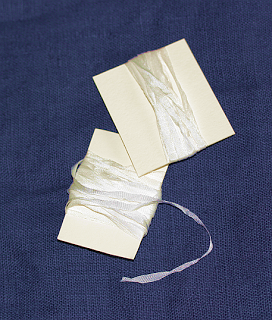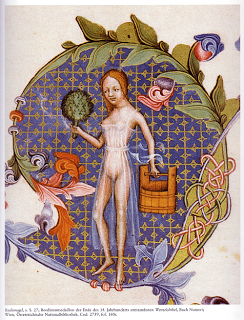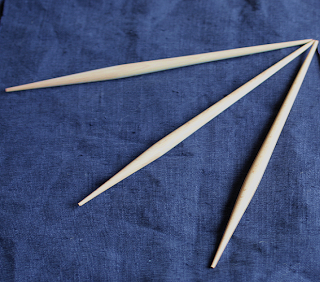While working on the real wood-and-cloth market stall, thinking about the selection and presentation of goods and working simultaneously on the "market stall" website, I'm pondering how to sort and how to present the goods on the website - and what and how much information to provide with each piece.
I carry a few replicas - like the spindle sticks, the netting needles, naturally dyed silk threads, and so on. However, I don't have "perfect" replicas for sale in the sense of the original material is used for the replicas (the correct metal, the correct wood) and that they are made using only medieval tools and methods (and that would be really pricey). In addition, I carry some goods that are part or complete conjecture - I have pincushions to keep pins and needles safe, I have parchment tablets for weaving. And finally, there are some things that are first seen later than the middle ages, like the "Nähsteine", where I'm actually not sure whether they were not used before the 17th or 18th century or whether usage was just so normal/unspectacular that they are not shown on the few pictures that we have from medieval sewing work.
When people come to me on the market to buy real-life, they can just ask and I can explain and discuss things with them. In the internet - not so easy. It is of course possible to mail or phone, but takes significantly more effort to do so.
So the big question is: Do I need to write the story behind each of the objects on the market stall webpage? Or would nobody care? Do you, as buyer of things as LH equipment want to know exactly what, where, when, why? (Personally, I would.) Comments and input, anyone?
I carry a few replicas - like the spindle sticks, the netting needles, naturally dyed silk threads, and so on. However, I don't have "perfect" replicas for sale in the sense of the original material is used for the replicas (the correct metal, the correct wood) and that they are made using only medieval tools and methods (and that would be really pricey). In addition, I carry some goods that are part or complete conjecture - I have pincushions to keep pins and needles safe, I have parchment tablets for weaving. And finally, there are some things that are first seen later than the middle ages, like the "Nähsteine", where I'm actually not sure whether they were not used before the 17th or 18th century or whether usage was just so normal/unspectacular that they are not shown on the few pictures that we have from medieval sewing work.
When people come to me on the market to buy real-life, they can just ask and I can explain and discuss things with them. In the internet - not so easy. It is of course possible to mail or phone, but takes significantly more effort to do so.
So the big question is: Do I need to write the story behind each of the objects on the market stall webpage? Or would nobody care? Do you, as buyer of things as LH equipment want to know exactly what, where, when, why? (Personally, I would.) Comments and input, anyone?







